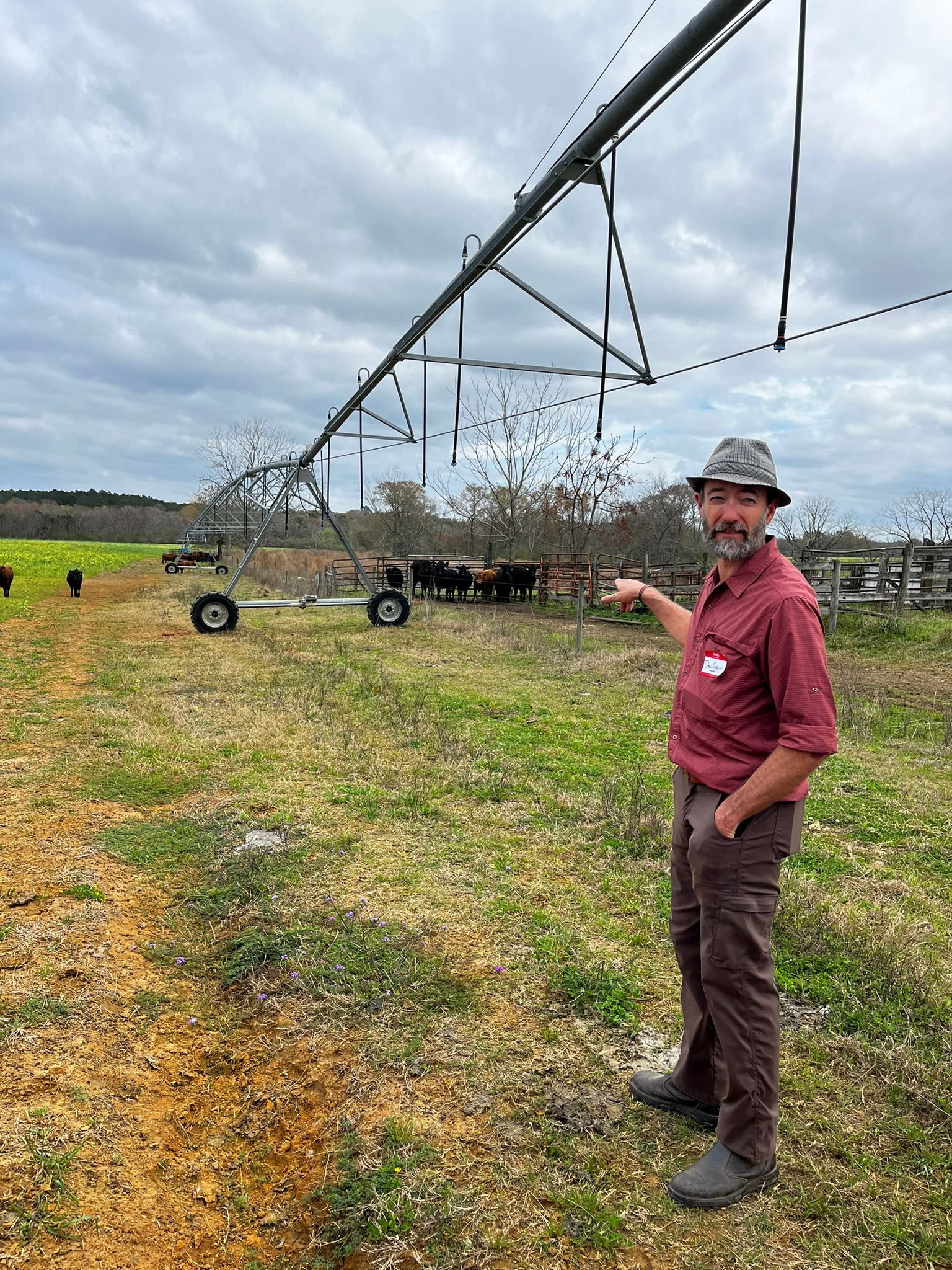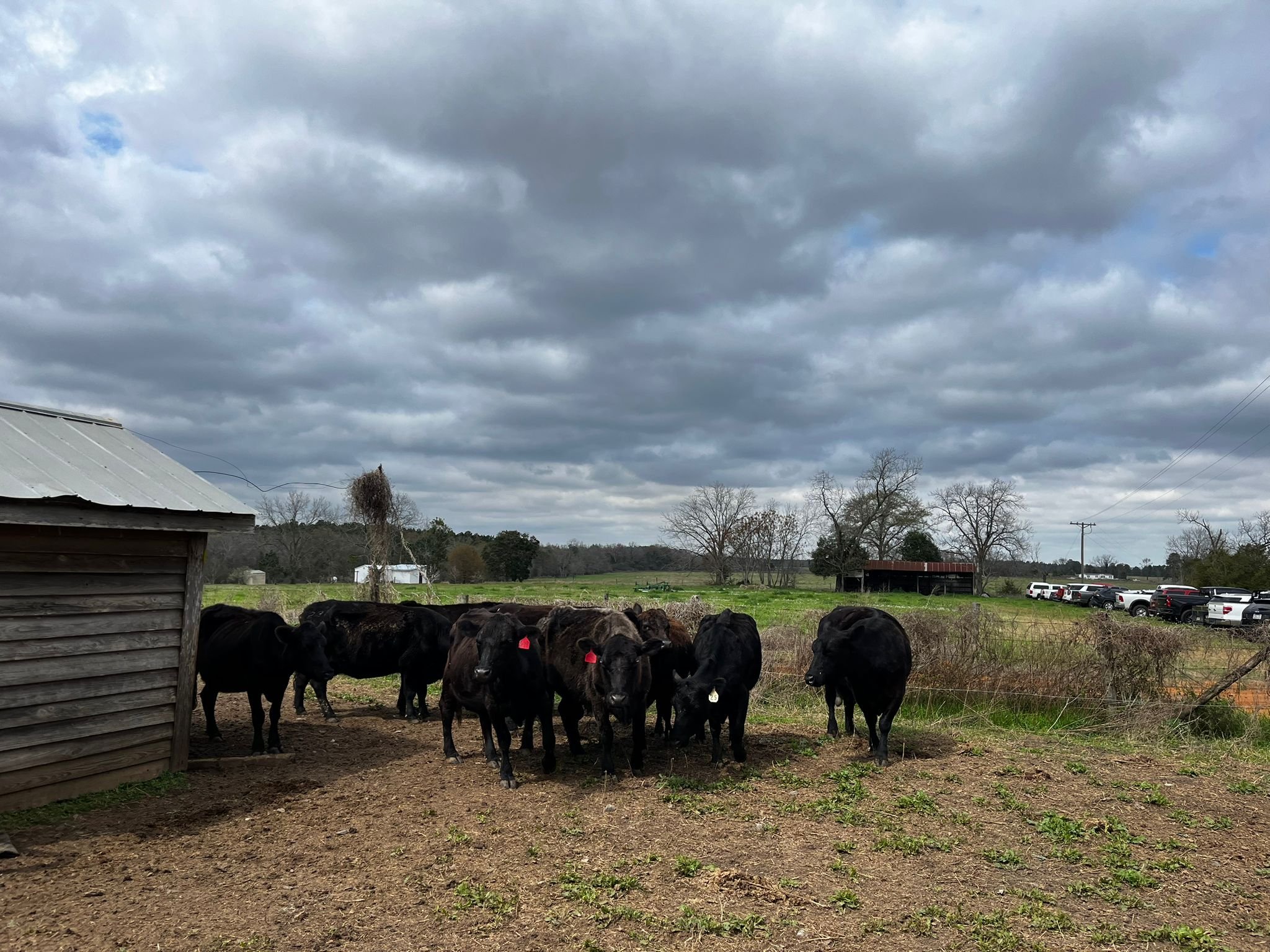By Lydia Hsu
Lydia Hsu is a Farmer Services Coordinator at Georgia Organics
On March 4, Georgia Organics hosted a “Climate Smart Grazing & Pasture Management” workshop, the third farmer field day installment of the 2024 Winter Farmer Series.
The Winter Farmer Series consisted of in-person networking and educational events hosted at farms across Georgia in February and March. These farmer field days took place in lieu of the annual Georgia Organics Conference & Expo, which has evolved to engage regenerative farm and food advocates across the U.S. Southeastern region under the moniker “SOWTH.”This series was created to ensure that farmers were still able to access valuable resources and continuing education opportunities during the slower winter season.
Deep Grass Graziers cattle. Photo courtesy of Dan Glenn.
The field day started off at the Irwin County High School C.A.S.E Farm with an educational session facilitated by Dan Glenn, owner-operator of Deep Grass Graziers, and Jonathan Fordham, owner-operator of Fordham Brothers Farm.
CATTLE BREED SELECTION AND SOIL HEALTH
Dan Glenn’s wealth of knowledge comes from self-education, from visiting other farms, attending field days, and most importantly, listening. He operates a 400 head cow/calf operation on 300 acres that uses minimal inputs, and champions climate smart strategies of regenerating soil health and breeding cattle genetics that are adapted to the Southeast. For instance, instead of raising grass-finished beef that is bred for frame or weight, Dan puts environmental pressures on the cattle that encourages self-selection for adaptability. According to Dan, there are no shortcuts in breed selection. When selecting cattle breeds, it is important to keep in mind that the Southeast region:
Gets a lot of rainfall, which makes the grasses “washy,” meaning they aren’t heavy in minerals or sugars, so the cows need a greater gut capacity to consume all the nutrients they need.
Has intense heat 6 months out of the year, and during this time, it’s also hot during the night; the cows need to be able to deal with continuous heat stress.
Has greater insect pressures, such as ticks and flies.
Epigenetics plays a role in the adaptability of heifers and calves. According to Dan, “You can always raise a better heifer, than you can buy.” Meaning that the cows raised in the environment of your farm are programmed to the feed you use, the insects on your farm, and the minutiae that are specific to your farm. If you’re not able to raise your own heifers, Dan suggests that you look for a breeder in your area, but stresses that it’s important to look for a breeder with similar practices to your farm. That way, the cow can more easily adapt to your farm.
One of Dan’s core values in running a profitable business is prioritizing his soil health. To do this, he follows these principles and practices:
Minimizing soil disturbances, both physically and chemically
Physical and chemical disturbances upset the soil biology. By not using pesticides, herbicides, or other chemical sprays, and moving away from tillage, Dan can build organic matter, water retention, and create a better bacterium to fungal balance in his soils.
Allowing multi-species biodiversity
Cows will eat plants that may be overlooked by humans as weeds or nonbeneficial species. When cows graze different plant species, it makes them healthier. That, in turn, benefits human health down the food chain.
Adding livestock to the cash crop cycle
Cows complete the nutrient cycle and help to foster and maintain improved soil biology.
Using regional context for decision making
Soil management practices that work well in a certain region might not in a different one. It is important to remain adaptable and flexible.
Around 6 years ago, Dan stopped using commercial fertilizer on certain grasses. As a result, the clover in the pasture seed bank has increased. By embracing and working with nature, Dan minimizes constantly running on a cycle of fixing problems, and he is better able to address root issues, not just the symptoms. Dan is willing to give up near term performance in exchange for investing time into adjusting and improving pasture and grazing management because that gives him more control over his business costs. The more costs he can control, the more resilient that makes him. Dan emphasized the importance of balancing resiliency and profitability, while also maintaining a passion for the work. He said it best by reminding field day attendees that, “The cattle business isn’t high enough margin for it not to be fun, so always keep it fun.”
Dan Glenn (Deep Grass Graziers) discusses cattle breed selection with attendees. Photo by Lydia Hsu.
BALE GRAZING
Jonathan Fordham and his brother started Fordham Brothers Farm in 2001 and transitioned a row crop farm to pasture on 120 acres with a 45 head cattle operation. He has been working with NRCS Grazing Specialist, Philip Brown, on bale grazing as a method of extending the grazing season as much as possible, while reducing his costs.
Traditional Feeding Methods vs Bale Grazing for Cattle
These different feeding methods vary in spatial layout, feeding constructs, cattle movement, and timing. The farmer must take into consideration many factors when determining which feeding method to use.
Traditional Feeding Methods:
Sacrifice area – Farms will set up one sacrifice area where all the cows are concentrated. Since the winter is wet, there’s mud and runoff making the area messy. Going in and out with a tractor to bring hay/feed every 1-3 days contributes to the land destruction.
Winter feeder – Due to heavy feeding concentrations, this has similar problems as a sacrifice area, with a lot of land destruction and mud.
Heavy use areas – Fordham Brothers Farm made a cattle corral by excavating 6-9 inches of soil, put in a geotextile fabric and pressure run gravel. While the cattle movement is concentrated, it can withstand the daily traffic and minimizes muddy areas. There will be litter and waste, but the area doesn’t get quite as messy or muddy as a sacrifice area.
Hay wagons – This allows the farmer to spread the cows out in different locations. Jonathan has used hay trailers and wagons before, but there was a lot of waste associated with it.
Bale Grazing Method:
Allocate hay/feed over a particular period a time before allowing the cows into the pasture to feed. You control the placement of the hay, so the cattle aren’t overly concentrated in one area, which helps distribute nutrients, manure, and waste in a systematic way across the whole pasture. This way, you reap the benefits of fertility while minimizing land and soil disruption.
Philip (NRCS) helped Jonathan implement bale grazing on his farm. They started with soil tests and chose a site with low fertility value so they could track the increase in fertility over the long term. With a water trough set up in one area, Jonathan uses a grid-like pattern to place the hay bales in 2-5 tons/acre density. Once the cows are finished with one row of hay, the farmers move the fencing so that the cows can access the next row of hay, with this process continuing each time the cows finish a row of hay. He’s improved the setup for his 2024 season so that there are shorter fence runs and not as much fencing to move with each hay row allocation. By learning from past issues and adjusting his management practices, Jonathan is able to continue improving labor efficiency on the farm and reduce his overall costs by extending the grazing season. Since the NRCS bale grazing initiative began on the farm, Jonathan said that in the past 2 years, they’ve already seen an increase in organic matter on the bale grazing site.
Jonathan Fordham (Fordham Brothers Farm) shows attendees the bale grazing experiment set-up. Photo by Lydia Hsu.
DEEP GRASS GRAZIERS FARM TOUR
After a delicious lunch where attendees could enjoy grass-fed burgers from Deep Grass Graziers, the field day transitioned to a farm tour. The first stop was a field that was once a monoculture, but now is full of multispecies diversity of various grasses and forage that are critical to the soil’s health, as Dan talked about in his earlier presentation. When an attendee asked if he was worried about the dandelions spreading out of control, Dan replied that he wasn’t, because he wants to see diversity in both above and below ground species, and besides, the cows would eat up all the young dandelion greens!
During the farm tour, attendees were also able to see Dan’s implementation of a bale grazing setup. Similar to how Jonathan had the bale grazing set up on his farm, Dan demonstrated his use of movable fencing which allows him to progressively introduce more hay/feed to the cows, instead of having to crank a tractor on a daily basis to move hay. His advice was to set up bale grazing in a well-drained area, like on top of a hill or slope, otherwise it will create a mess.
In multiple instances on the tour, Dan pointed out the cow manure in the field as an indication of the cows’ nutrient intake. NRCS Regional Soil Health Specialist, Mark Kopecky, discussed how the nutrients in cow waste can give you clues on your soil fertility. Since phosphorous is primarily excreted in the feces, and potassium is primarily excreted in the urine, you can visually see in your field if your cows have a nutrient imbalance. Similarly, when Dan reads the manure patties, he’s able to tell if the cows are getting too much protein or not enough by regularly scanning the fields visually, and can use this data to make decisions on whether to supplement their feed, to change hay sources, etc.
This intuitive thinking is built from years of experience, something that develops like the ‘grazer’s eye’ which is Dan's method of determining how many cows to put in a pasture and for how long. By sharing his expertise and lessons learned, the farmer attendees were able to walk away with years of knowledge and lots to graze on (no pun intended).
All said, it was an impactful day of knowledge-sharing, with learning about climate smart practices and pasture management in the morning and being able to see examples of those practices in the field during the farm tour.
Dan Glenn leading attendees on the Deep Grass Graziers farm tour. Photos by Lydia Hsu.
WE’RE PROUD TO PARTNER WITH GEORGIA FARMERS
Thank you to Dan Glenn of Deep Grass Graziers for hosting us on the farm, inviting us into conversation, and teaching us about your operation. Thank you to Jonathan Fordham of Fordham Brothers Farm for sharing your expertise on bale grazing practices.
To learn more about Deep Grass Graziers, visit deepgrassgraziers.com or follow them on Facebook (@DeepGrassGraziers).
To learn more about Georgia Organics visit georgiaorganics.org or follow us on Facebook, Instagram, Threads, LinkedIn, and YouTube.
To view the resources passed out from the field day, click HERE.
To learn more about our Georgia Organics Farmer Services programming, check out our website farmerservices.georgiaorganics.org.
Want to keep up to date on future farmer-focused events, farmer resources, updates, and news? Join our monthly e-newsletter, the Grower News, for all the latest! Sign-up HERE.
FUNDING ACKNOWLEDGEMENTS
This event was supported through the United States Department of Agriculture (USDA) Transition to Organic Partnership Program (TOPP). TOPP is a program of the USDA Organic Transition Initiative and is administered by the USDA Agricultural Marketing Service (AMS) National Organic Program (NOP).
This event is supported through Drawdown Georgia Climate Solutions & Equity Grant Funding Partners.







